BEATRIZ SANTIAGO MUÑOZ with Rin Johnson
Rin Johnson
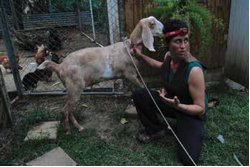
Beatriz Santiago Muñoz, Black Beach/ Horse/Camp/The Dead/Forces, 2016. 16 mm black-and-white film, with sound, 8 min. Courtesy the artist and Galería Agustina Ferreyra
Pérez Art Museum Miami is currently presenting a selection of her works, A Universe of Fragile Mirrors, while Beatriz Santiago Muñoz: Song, Strategy, Sign is on view at the New Museum in New York. The latter includes That which identifies them like the eye of the Cyclops (2015), which takes its themes from Monique Wittig’s 1969 novel Les Guérillères surrounding the lives of women after a blood battle of the sexes. The video installation weaves in and out of the real lives of a group of women in Puerto Rico. Rin Johnson spoke with the artist at the New Museum.
_____________________________________________
RIN JOHNSON (Miami Rail): I’m curious about the relationships you create for the viewer. Your work feels carefully intimate, and I’m wondering how you understand the relationships you have with your subjects?
BEATRIZ SANTIAGO MUÑOZ: The thing that most interests me is a kind of unstructured encounter between two people, where each brings their subjectivity and you affect each other and create. I definitely see that I think with somebody else. For example, this woman here [gestures toward That which identifies them like the eye of the Cyclops], Eva. She’s a painter who has worked for twenty years with this kind of Plexiglas material and light. One of the things I was trying to work out with her is a new language to be used in battle. And so it’s not just me thinking, but it’s me thinking with her—there is a space for understanding and for misunderstanding, so a lot of interesting things can happen. I’m interested in the idea of shared subjectivity. But I don’t want to present it as a horizontal or equal collaboration, either, because I realize there is kind of a push-and-pull in there with many people that I work with, where shared subjectivity is not a tranquil thing, but it is a thing—a tension—that is not entirely understood.
RAIL: When did you first encounter Monique Wittig’s novel Les Guérillères? What felt necessary about using it in your work?
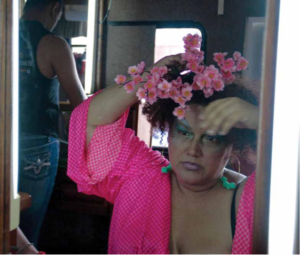
Beatriz Santiago Muñoz, Black Beach/Horse/Camp/The Dead/Forces, 2016. 16 mm black-and-white film, with sound, 8 min. Courtesy the artist and Galería Agustina Ferreyra
SANTIAGO MUÑOZ: When I was in college—I think my first encounter was through a friend. It may have been discussed in a feminist theory class I was taking. I was talking to [New Museum curator] Johanna Burton about it, and we both realized that this was an important book in our academic formation, but that it has kind of disappeared from the curriculum, perhaps because it directs you toward a radical feminist moment where all the issues are far from the discussion right now. It is a book that I carried with me psychically because of the very clear idea that in order to get to radical political ideas you need to pass through a radically experimental form and attempt to create a new language, new myths. It’s not a new idea; it’s sort of the basic idea of all sorts of twentieth-century avant-garde work, that there is a relationship between radical politics and radical form. The thing that seemed really clear to me was that it is through the form that you get to a different vision. Wittig speaks about the interval—what is not said and not named—which is the inherent contradiction in the creation of a new language. From the beginning, there are spaces that are impossible to name; if named, they become fixed into another system of thought. So I kept going back to this idea.
But, I didn’t quite know how to work with the text. My work doesn’t usually start from a fixed text. It usually starts from interest in a person or a group of people and then I write a little bit and then go to the person with my text and then we start messing with it. Wittig was interested in creating this universal female subject, but I, of course, am suspicious of the universal female subject. I was thinking about all these women who are part of my immediate community in Puerto Rico, and if I could take it from that very specific place, from these five women—the way they live and their bodies and their material world. What happens when you take Les Guérillères and make it very particular, locating it in a particular place and history? I knew that I had to concentrate on how you hold your body. Wittig sometimes references uniforms or masks or identifying qualities of a group of people, so I also wanted to think about how materials and objects, like masks, create a new identity and how the idea of creating a new identity is a kind of abstraction—a chosen identity, a you/not-you. Those mask-objects in the exhibition are not used in the film yet, but they will be, so this is still the beginning of the process.
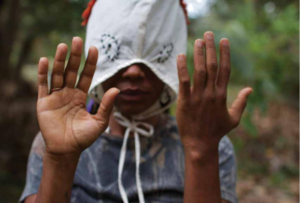
Beatriz Santiago Muñoz, Black Beach/Horse/Camp/The Dead/Forces, 2016. 16 mm black-and-white film, with sound, 8 min. Courtesy the artist and Galería Agustina Ferreyra
RAIL: Wittig says, “Whatever…does not appear in the language you speak…this can be found in the gaps, in all that which is not a continuation of their discourse.” Looking around, I’m thinking about the museum as an institutional space, and while at times it feels like “this is a great place to be getting ideas that are challenging these hierarchies,” at the same time, I don’t know—what do you think?
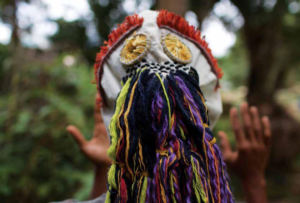
It’s the same thing that happens when showing all the postmilitary cinema work at Pérez Art Museum Miami, and it’s a question that I consistently get when I talk about the work and the work’s intention, because of what happens once it’s decontextualized out of its main thrust. The way we are used to thinking about the military landscape is to identify ourselves with that image of domination. So there is work that needs to be done in order to break that identification. So think about the space differently, maybe by breaking the plane of the camera, maybe seeing somebody else that knows the place in a different way, somebody who was kicked out of that land sixty years before. “Let’s try looking this way! Let’s try looking this other way! Let’s try all these different forms!” That is the intention of the work.
But once it’s in a museum space, which is aestheticized, its political intention, which comes out of formal experimentation, may just turn into something beautiful—it may just turn into something that speaks to histories of experimental film, but doesn’t speak to the question of how do you see and live and imagine another possibility for a postmilitary space? How do you see it not as a ruin or as nostalgia, but as an other thing? How do you create that other?
I can see a work that is set in New York or Berlin or London and I am really familiar with the political histories that create the material circumstances (or the visual circumstances) of that work, but the same is not true for viewers from those parts of the world looking at something from other parts of the world. They don’t necessarily know how to understand the visual or material consequences of those histories. Sometimes I wonder: “Is it my role to bring that entire context to bear on the work, so that I can help this viewer who doesn’t have this context?” I don’t think artists can be tasked with correcting those asymmetries in the world, and maybe it is a good thing to not understand for certain viewers, to only be able to get to a certain point and to be repelled. There is something past this repulsion that has to do with understanding the history of the place and the political circumstances that created it. Maybe opacity is a good thing at certain moments, to create another language without being understood.
RAIL: This idea of going along with someone, conversing alongside them, but then realizing that there are barriers within your language…
SANTIAGO MUÑOZ: Exactly, there are these gaps. I hadn’t thought about that parallel relationship, that there will be gaps of understanding between an audience that is not necessarily familiar with the place, though I think that the New Museum exhibition might be a lot easier, with many more points of contact than the one in Miami, which has so much work that has to do with places that people are not so familiar with in the United States.
RAIL: Thinking more about spaces where work can live, I was happily surprised to discover how much of your video work I could find online. I wondered if you make it accessible so that viewers could come back to it or if it’s more just like, “people need to see this so I’ll throw it up there…?”
SANTIAGO MUÑOZ: I’m not very precious with the work. I think I saw a lot of things that really affected me in shitty resolution, and I always think, “if it doesn’t hold up in shitty resolution, it just doesn’t hold up.” It’s OK—you don’t have to see it in the perfect setting, mostly because I don’t think there is a perfect setting. I always think the perfect setting was when we shot it.
RAIL: How do you feel viewers will react to the worlds you’ve created here?
SANTIAGO MUÑOZ: These images are very simply thinking about the relationship between signs and naming, and the responsibility of creating new signs and a new language—very simple things about movement, rhythm, light. Those are such simple formal decisions, but they allow us to think about how very simple decisions of language and visual language actually have all sorts of ethical, moral, and political consequences; it was important that the language be very simple because of that. There is an element in the audio when you hear Evalize saying, “Look, I’m holding it like an archer.” She is raising a piece of Plexiglas with a color and, at that moment, she’s saying—look at my position, look at my body in relation to this—and it’s very simple, but this is the work that I’m interested in. From then on, you only hear me saying the things that she says: “she says this, and she says, does it have to be only functional, should it be beautiful?” These are the essential questions for me. What is language for them? What else does it do besides communicate? It does so many things that are not just for naming. I hope that the first thing this work does is to propose the complexity of even the most basic aspects of language, like: How do you name? What do you name? What is naming for?
RAIL: Also: Who is allowed to name, and when?
SANTIAGO MUÑOZ: Yes. The other thing is that Les Guérillères is so much about the universal female subject, and so then how do you think about the female subject from these very specific places so that it is not the universal European female white subject, so that it is a subject that is crossed by the colonial political histories that are so evident in Puerto Rico. I make work from the territory that I live in and I believe that there are things that you can think.
RAIL: Moving through the space of the New Museum trying to look at all of Cyclops at the same time is hard to do; the second you pass by one projection panel, it’s like, “Oh, I am seeing the reflection of what I was just watching.” So there is this really fun experience of giving your body over.
SANTIAGO MUÑOZ: There are a lot of things happening. I made it, and I am discovering things, but I am one of those people who can stare at lights and shadows for a long time.
There is also the matter of the objects. I have shown objects in a couple of shows before, but these are props and masks to be used, and I wanted to know if you can have objects in the space people will think of as active things—will they do some work? The ceramic objects refer to body parts, which refer to moments in the text—images that stay with me from the text that I’ve used without saying it. There’s part of the text where Wittig says the horses came back riderless, and in Vieques there are three thousand wild horses just walking around by themselves. They have a very symbiotic relationship with the people who live there, but they have their own pace, they are horses that don’t move with anybody else. They acknowledge you, but they do something else between each other and you can recognize this other subjectivity that is not human subjectivity.
There are also these abstracted body parts that I’m going to use as props, so when the women are carrying bodies back, they aren’t carrying bloody things that look like flesh, just beautiful objects that are heavy and that you need to hold and that make you think about the relationship between one body and another.
RAIL: I think of that funeral scene in Les Guérillères—the body they carry around that jingles!
Santiago Muñoz: Yeah, that’s an image that I’m definitely going to use in the final film, Verano de Mujeres. So these are all objects that are maybe more meaningful to someone who knows the text. Then Vieques is a project that I’m doing in parallel, it’s not part of Verano de Mujeres, but I feel like you can see that this other fictional work is also from a very specific place and it is related to, just slightly separated from, reality.
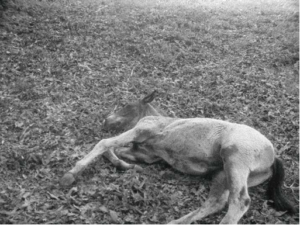
Beatriz Santiago Muñoz, That which identifies them like the eye of the Cyclops, 2016 (production still). Three-channel digital color video, with sound, 10 min., 11 sec. Courtesy the artist and Galería Agustina Ferreyra
SANTIAGO MUÑOZ: I’ve always been very interested in ethnography and what it is that attracts one to an ethnographic image. What is it that you are actually seeing? Are you seeing the real, a performance of the real, or are you seeing ethnography of the person behind the camera? Because the camera person’s point of view and the way they are looking is more present than what is happening in front of them, so the idea of any ethnography is a shared ethnography—like a set of decisions taken between the person in front of and behind the camera. So we’re asking ourselves how we really move, how we really think, and what can we do together? This is as real as anything else and that’s the part that I am interested in and it is also a process that is fun and surprising.
The last project that I did in Haiti—I knew that I wanted to work in the Marche Salomon after the first time I went there. I was fascinated by [the market], but I also realized you can’t pull out a camera there, it would just be too violent. But I kept also asking: “How would it be possible? How would you do it in a way in which, in the end, the other person said, ‘let’s do this’?” I started first recording sound and in recording the sound I became interested in this idea of the mystical objects. In the end, I learned that Haitians refer to things as a simple object or a not simple object. So a simple object doesn’t have any magical properties, like a bottle, a plastic bottle of water—well, actually a plastic bottle of water is not a simple object [laughs], but not many elements are simple in the world.
RAIL: Nothing.
SANTIAGO MUÑOZ: So the question really was about transcendence versus immanence which is something that I think about a lot, especially in relationship to Vieques. This is a question that has come up in religion for thousands of years: Is the divine in the objects of the world? Can you find it in material experience? Or is the divine in everything except what is in the world and what can be named? This is actually even related to Les Guérillères, because if you can name it, if you can see it, and you can touch it, then it is of the world and it is not divine, and it doesn’t present this other possibility, so there is always this imagined other space. I was interested in asking this question of the people in the shops or the people that were shopping in the marche, and especially of the people that worked with the meat, who were killing animals and were cleaning the animals and would have to have a relationship with the animal in a way that nobody else does. So just giving an example of one of those processes, slowly talking to people so that we understand the ideas first, so the moment when I say—“How about if we shoot this and record this and I have this script and what do you think?”—there is already something like a process established and a certain amount of interest in doing it, as well.
RAIL: I teach image literacy and we’ve been going back and forth about images having become like a Rolodex, while simultaneously having this issue when looking at an image and thinking, “I couldn’t say exactly where I’ve seen this before, but I know I’ve seen it one hundred times.” I’m wondering if you’re thinking about these repeating images or working with this at all, or if you find this to be a barrier to this possibility of creating new languages set out by Wittig?
SANTIAGO MUÑOZ: I think it’s a common idea to think that there are so many images already created of everything, but I am from a place where it is very clear that there are not enough images—there are only certain ways that certain people and places have been looked at. You can trace this to very concrete things. When the US Navy created the base there (the largest US Navy base outside of the continental US), you couldn’t even see the bombings that took place for sixty years. There were no images of it at all. The only images were the aerial images that they would produce. So the only image of this place, where people knew other kinds of perspectives, uses, skills—all these very material, formal qualities of the way one relates to a place—all of this was replaced with monumental, aerial, rational, mechanic movement, which was aestheticized in a very military way. Even images of the troops were aerial in formation, so the way in which we get used to seeing the landscape and to understanding ourselves within it and the possibilities of the place is within these distant views. There are very clear connections to the ways that the military has seen this place—the landscape and the people—to the way that the service and tourism industry sees the place. The kind of lens you use, the point of view, the way the camera moves, the identification with the drone, the idea of the aerial view, what you can see and what you can’t.
Sixty years makes a difference in how visual thinking or sensorial or material thinking can contribute to imagining another way in which to live in the place. I mean that very literally, because then the base closes after a period of civil disobedience and the monumental nature of the military base allows for only a certain kind of thinking about the place, so that you think of it as if nothing is happening there. It is a ruin simply because the things that were happening before are not happening, but in fact, many things are happening.
Puerto Rico is tropical, and one of the things I learned a few years ago is that in the tropics a secondary forest becomes indistinguishable from a primary forest in sixty years; so it’s already, after being closed for ten years, 1/6th of the way from becoming indistinguishable from a primary forest. When you start listening, there are actually thousands of events happening there, they are very different kinds of events in terms of scale in comparison to a military operation, but they are there, they can be perceived and understood. So yes, I agree we have a certain set of images that allow us to see a certain possibility, that allow us to only identify with certain literal points of view that then have political and ethical points of view attached to them. For me, I like thinking a lot in this very crude way, like I’m not interested in the camera moving like a machine, I’m not interested in an aerial point of view, I’m not going to reproduce this. It may be a very simple way of thinking, but we have to start breaking these formal decisions that we are so used to and that’s in everything.
I think for the Verano de Mujeres project I am lost in the process still, where I am asking myself how to create that collective subject in a way that is from a specific subjectivity as opposed to the universal female subject. Like, how does it happen, visually, how do I even look? And those are questions that I am asking myself, but I don’t think yet are beginning to be resolved in the images. I am having fun taking some cues from Les Guérillères. The text is circular, so this is circular…I am really, really trying to force myself to think in circular ways.
Rin Johnson is a writer and artist based in Brooklyn.









